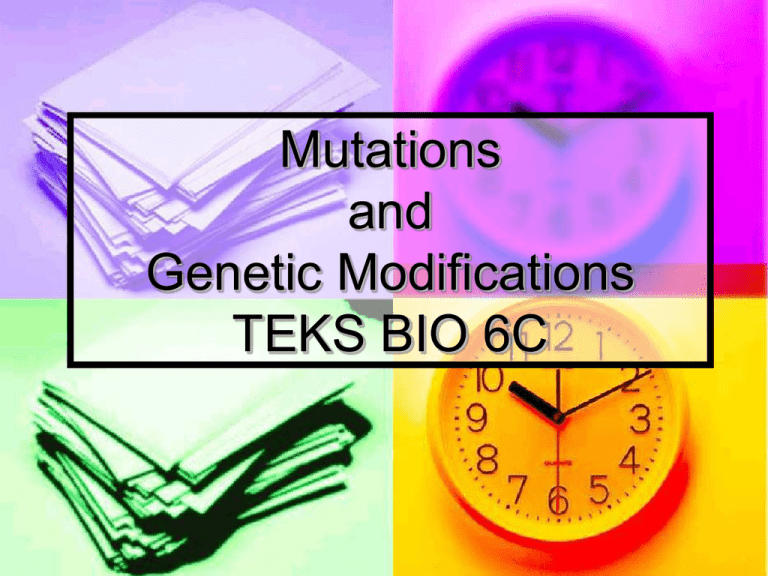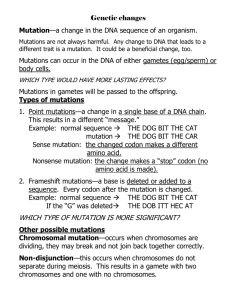Amino Acid Substitution
advertisement

Mutations and Genetic Modifications TEKS BIO 6C Eagle Zone (Explain)- don’t be lazy! Use a book if you don’t know the answer Use the words codon, amino acids, and protein in ONE sentence which describes their association with each other. Why does DNA not participate directly in protein production? What is a mutation? Are all mutations harmful? Why or Why not? Can mutation be helpful? How? Engage: One Wrong Letter Explore: What about Mistakes?? Mutation Any changes to the genetic material of a cell Modeling Chromosomal Mutations (coloring activity) Mutations How can mutation occur? Simple replication errors in DNA Environmental Mutagens How Mutations Happen Types of Mutations Point Mutations Base Pair Substitutions Base Pair Insertions and deletions Silent Missense – new protein (Amino Acid Substitutions) Triplet Repeats Frameshift Mutations Variation in Chromosome Number Chromosome Abnormalities Deletions Translocations Duplications Inversions Point Mutations Potential Results of Point Mutation Look at your codon chart or codon wheel. What would happen if the following Point Mutation Occurred: CCACCC GGAGGU UCUUCA Amino acid meaning was not altered Silent mutation Potential Result of Point Mutation One Amino Acid Substituted for Another Sickle Cell Anemia Valine is replaced with Glutamic Acid Point Mutations: Frame Shift One or more bases are inserted or deleted into the sequence of the gene How many letters of DNA can a ribosome read at one time? three letter "words” adding or removing one letter changes each subsequent “word” These mutation can make the DNA meaningless shortened and functionless protein Deletion Frame Shifts A deletion of one or more bases on a section of the chromosome. Base Pair Insertions (Triplet Repeats) Occurs when DNA is not copied correctly and a segment is repeated Ex) Huntington Disease—CAG Repeat Variation in Chromosome Number Having any number of chromosomes that does not equal 23 pairs. Ex) Down Syndrome – 3 Chromosome 21’s Chromosome Abnormalities -Translocations -Duplications -Inversions Translocations When one piece of a chromosome breaks off and attaches to another chromosome Duplications Occurs during crossing over and one chromosome ends up with more genes than it received. Inversions A reversal in the order of a segment of a chromosome Heredity, Mutations, and Inheritable Diseases Elaboration 1 The next several slides will give you information concerning a particular mutation. On your paper describe the overall affect this mutation may cause. Types of Mutations DNA Sentence - Mutation - If this was a DNA sequence, what would this type of mutation be called? Could this change cause the polypeptide sequence to change? How? If this type of mutation occurred, what, if any, might be the possible consequence for the organism? THE FAT CAT ATE THE WEE RAT THE FAT HAT ATE THE WEE RAT Types of Mutations - THE FAT CAT ATE THE WEE RAT THE FAT KAT ATE THE WEE RAT Original Sample Gene Mutation - If this was a DNA sequence, what would this type of mutation be called? Was the meaning of the gene sentence altered? If this type of mutation occurred, would there be any consequence for the organism? Types of Mutations - THE FAT CAT ATE THE WEE RAT THE FAT CAA TET HEW EER AT Original Sample Gene Mutation - If this was a DNA sequence, what would this type of mutation be called? Could this change cause the polypeptide sequence to change? How? If this type of mutation occurred, what, if any, might be the possible consequence for the organism? Types of Mutations - THE FAT CAT ATE THE WEE RAT THE FAT ATE THE WEE RAT Original Sample Gene Mutation - If this was a DNA sequence, what would this type of mutation be called? Could this change cause the polypeptide sequence to change? How? If this type of mutation occurred, what, if any, might be the possible consequence for the organism? Types of Mutations - THE FAT CAT ATE THE WEE RAT THE FAT CAT XLW ATE THE WEE RAT Original Sample Gene Mutation - If this was a DNA sequence, what would this type of mutation be called? Could this change cause the polypeptide sequence to change? How? If this type of mutation occurred, what, if any, might be the possible consequence for the organism? Elaboration 2 You will watch the movie Lorenzo’s Oil and complete the film guide questions. This film will review several concepts we have already covered and will introduce several new concepts to be learned. Evaluation The next several slides will show different types of mutations. In your lab book, name each of the following mutations. What Type of Mutation? Genetic Modification Where can it lead? Eagle Zone- Complete this orally-5 minutes Review questions: How many bases does it take to make a codon? 3 What are the building blocks of proteins? Amino acids What is used to look up amino acids codes? mRNA codon chart Evaluate 2- PICTURE IT! Modeling Mutations Card Activity • Students will receive cards, representing nucleotides, and line the cards up in a particular genetic sequence PART 1 • Students will use colored paper to write the mutated sequences for these mutations: – Deletion – Insertion (insert any new base into the sequence) – Base Repeat (repeat any single base 3 times) • Take a picture of the sequence after completing each mutation PART 2 • Students will use colored paper to: – Write the mRNA sequence – Write the amino acid sequence • Take a picture of these sequences when complete Karyotyping and Pedigrees TEKS BIO 6D What is a Karyotype A Karyotype is An organized profile of a person’s chromosomes represented by a picture of the person’s individual chromosomes Reading Chromosomes Characteristics Chromosomes are arranged and numbered by size, banding pattern, and centromere position Size ranges from largest chromosome to smallest chromosome What is the purpose of a karyotype? To help scientists quickly identify chromosomal alterations that may result in a genetic disorder Elaborate/Extend •Class practice: match the chromosomes with their correct sister in the online game CLASS PRACTICE •Karyotyping Activity: Match chromosome parts in the envelope with the karyotype your group is given. This activity will help you practice understanding what causes genetic disorders and will serve as an introduction to mutations Pedigrees What is a pedigree? •similar to a family tree •Shows genotypes and phenotypes of a genetic trait through several generations of a family Molecular Genealogy Animation Pedigree Analysis Autosomal Recessive Inheritance a pattern of inheritance resulting from the transmission of a recessive allele on an autosome (a chromosome other than a sex chromosome) Males and females are affected with equal frequency There may be no family history of the trait; it becomes manifest when two carriers have a child who is homozygous recessive Examples are: Cystic fibrosis, phenylketonuria, and galactosemia Pedigree Analysis Autosomal Dominant Inheritance a pattern of inheritance in which the transmission of a dominant allele on an autosome causes a trait to be expressed Males and females are affected with equal frequency If one parent is homozygous for the dominant allele, all of the children will express the trait Examples: Achondroplasia, osteogenesis imperfecta, polydactyly, Marfan's syndrome, and some neuromuscular disorders Elaborate/Extend Family Pedigrees activity Utah website for practice and more information on your disorder: http://learn.genetics.utah.edu/ Explain Meiosis- Making Reproductive Cells (Sperm and Eggs) Event Mitosis Meiosis Two cell divisions Centrioles appear Chromosomes pair up Spindle fibers form Cytokinesis Two daughter cells Four daughter cells Draw the chart into your lab book. Fill in the chart as we watch the animation. Meiosis Animation Explore- Modeling MeiosisStraw activity Use yarn to represent cell membrane and nuclear membrane (when present) Cut out straws of different colors to represent the phases of meiosis 1 and meiosis 2. Use your Phases of Meiosis notes as a guide








